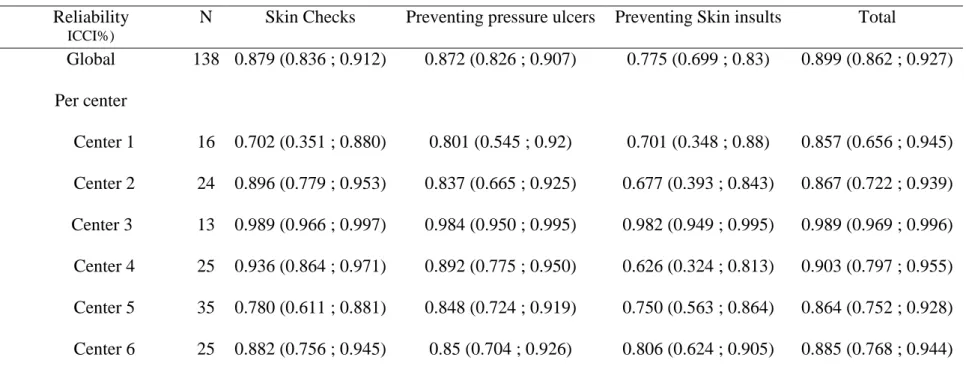HAL Id: hal-00702066
https://hal-univ-bourgogne.archives-ouvertes.fr/hal-00702066v2
Submitted on 30 May 2012HAL is a multi-disciplinary open access
archive for the deposit and dissemination of sci-entific research documents, whether they are pub-lished or not. The documents may come from teaching and research institutions in France or abroad, or from public or private research centers.
L’archive ouverte pluridisciplinaire HAL, est destinée au dépôt et à la diffusion de documents scientifiques de niveau recherche, publiés ou non, émanant des établissements d’enseignement et de recherche français ou étrangers, des laboratoires publics ou privés.
Evaluating self-reported pressure ulcer prevention
measures in persons with spinal cord injury using the
revised Skin Management Needs Assessment Checklist:
reliability study.
Anthony Gélis, Jean-Pierre Daures, Charles Benaim, Paul Kennedy, Thierry
Albert, Denis Colin, Pierre-Alain Joseph, Jacques Pelissier, Charles Fattal
To cite this version:
Anthony Gélis, Jean-Pierre Daures, Charles Benaim, Paul Kennedy, Thierry Albert, et al.. Evaluating self-reported pressure ulcer prevention measures in persons with spinal cord injury using the revised Skin Management Needs Assessment Checklist: reliability study.. Archives of Physical Medicine and Rehabilitation, WB Saunders, 2011, 49 (5), pp.653-8. �10.1038/sc.2010.177�. �hal-00702066v2�
Table 1 : Back-translation Cycles. Values are mean scores. The item translation is validated if comparability of language mean score <3 or similarity of interpretation mean score <2,5.
First back-translation Cycle Second Back-translation Cycle
Items Comparability of language Similarity of interpretation Comparability of language Similarity of interpretation S kin C he cks 1 1 1 - - 2 2 1 - - 3 1.66 1.83 - - 4 3.66 3.66 1.66 1 P re ve nti ng pr essur e ulce r 1 2.16 2.16 - - 2 2 1.83 - - 3 4.33 4.5 2.16 1.83 4 4.16 4.16 2 1.66 P re ve nti ng wounds 1 1.66 1.5 - - 2 2 2 - - 3 3.83 4 2.16 1.66 4 3.5 3.66 2.66 2.33
Table 2 : clinical and demographics characteristics of the persons with SCI included in the study (N=138)
Characteristics Total (N=138)
Demographics
Age (year) 45.9 ± 14.9 (E:19-82)
Sex Men 103 (75) Women 35 (25) Weight (kg) 70.4 ± 14 (E: 37-114) Height (m) 1.73 ± 0.09 (E : 150-197) BMI (kg.m-2) 23.9 ± 3,7 Lesion characteristics
Âge at the time of the injury (yrs) 38 ± 16 (E:10-82)
Age of the injury (month) 94 ± 127 (E :1-696)
ASIA Score A 83 (60) B 16 (11,5) C 15 (11) D 14 (10) Lesion level Cervical 49 (36)
Upper and lower back 89 (64)
Etiology Traumatic Medical 112 (81) 26 (19) Skin characteristics Braden (6-23) 15.8 ± 3 (9-23) Pressure Ulcer Number 0 1 2 3 91(66) 35 (25) 7 (5) 4 (3) Location Sacrum Ischium 23 (50) 11 (24) Heel 4 (9) Trochanter 3(6) Others 5 (10) Stage (NPUAP) 1 2 6 (13) 11 (24) 3 17 (37) 4 13 (28)
The results are presented in Mean ± Standard-deviation or N (%) ASIA : American Spinal Injury Association
Table 3 : Global reproducibility and reproducibility per Center for the revised SMnac and its subscores.
Reliability
ICCI%)
N Skin Checks Preventing pressure ulcers Preventing Skin insults Total
Global 138 0.879 (0.836 ; 0.912) 0.872 (0.826 ; 0.907) 0.775 (0.699 ; 0.83) 0.899 (0.862 ; 0.927) Per center Center 1 16 0.702 (0.351 ; 0.880) 0.801 (0.545 ; 0.92) 0.701 (0.348 ; 0.88) 0.857 (0.656 ; 0.945) Center 2 24 0.896 (0.779 ; 0.953) 0.837 (0.665 ; 0.925) 0.677 (0.393 ; 0.843) 0.867 (0.722 ; 0.939) Center 3 13 0.989 (0.966 ; 0.997) 0.984 (0.950 ; 0.995) 0.982 (0.949 ; 0.995) 0.989 (0.969 ; 0.996) Center 4 25 0.936 (0.864 ; 0.971) 0.892 (0.775 ; 0.950) 0.626 (0.324 ; 0.813) 0.903 (0.797 ; 0.955) Center 5 35 0.780 (0.611 ; 0.881) 0.848 (0.724 ; 0.919) 0.750 (0.563 ; 0.864) 0.864 (0.752 ; 0.928) Center 6 25 0.882 (0.756 ; 0.945) 0.85 (0.704 ; 0.926) 0.806 (0.624 ; 0.905) 0.885 (0.768 ; 0.944)
Table 4 : test – retest reliability of the items for the revised SMnac (weighted kappa coefficient) SMnac
Categories
Items for each category
1 2 3 4 5 6 7 8 9 10 11 Skin Checks 0.91 0.74 0.66 0.74 - - - - Preventing Wounds 0.58 0.60 0.54 0.50 - - - - Preventing pressure ulcer 0.64 0.60 0.57 0.47 0.71 0.60 0.61 0.62 0.70 0.50 0.58


